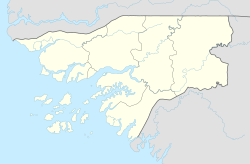Saltinho (Guinea-Bissau)
| Saltinho | ||
|---|---|---|
|
|
||
| Coordinates | 11 ° 37 ′ N , 14 ° 41 ′ W | |
| Basic data | ||
| Country | Guinea-Bissau | |
| Leste | ||
| region | Bafatá | |
| ISO 3166-2 | GW-BA | |
| Residents | 78 (2009) | |
|
The bridge over the Rio Saltinho Corubal, 1955 as Ponte General Craveiro Lopes built
|
||
Saltinho ( port. For "small jump") is a small town in the south of Guinea-Bissau with 78 inhabitants (2009). Its name is derived from the rapids with which the Rio Corubal jumps over rock formations.
The place is located 175 road kilometers southeast of the capital Bissau and belongs to the administrative sector of Xitole south of the Bafatá region .
The place name Saltinho will slowly emerging tourism often the country as a synonym used for the attraction of the local rapids and bridge.
history
Saltinho was established in the mid-1960s as a military camp of the Portuguese Armed Forces during the colonial war in Portuguese Guinea (1963–1974). Various companies were stationed here, including a. the CCAÇ 3490 of the Jäger Battalion 3872 in Galomaro , the CCAÇ 2406 of the Jäger Battalion 2852 in Bambadinca , and the CCAÇ 2701, which also belongs to Bambadinca.
The area was hotly contested, as supply routes for the PAIGC independence fighters from nearby Guinea-Conakry ran here and the strategically important bridge had to be defended.
Attractions
The former Saltinho military camp is now a pousada . The simple hotel complex, mainly visited by Portuguese war veterans and hunting and nature tourists, offers a wide view of the surrounding landscape with the rapids and small waterfalls on the Rio Corubal .
A Portuguese bridge with concrete arches leads over the river, which was built in 1955 as Ponte General Craveiro Lopes and visited on May 8, 1955, before completion, by the namesake, President General Francisco Craveiro Lopes . A bronze plaque on the bridge reminds of the date.
From the new bridge you can see the flooded ruins of an earlier stone bridge of the Portuguese in the river. Women from the surrounding villages often wash laundry, dishes and their children here. The view of the bridge, the river leaping over rocks and the washerwomen are frequent photo opportunities for tourists and photographers.
Web links
- Impressions of the bridge and the rapids of Saltinho , photo clip on YouTube
- Detailed private video of the bridge and the rapids of Saltinho private video on YouTube
- Pictures of the guest house and the surroundings of Saltinho on a blog of Portuguese Guinea veterans
Individual evidence
- ↑ Inhabitants by region, sector and town by gender, 2009 census (p. 81), PDF access from the National Statistics Office INE of January 20, 2018
- ↑ a b c d Joana Petrolho, Marta Rosa: À Descoberta da Guiné-Bissau . , Afectos com Letras / EU , Pombal 2015, ISBN 978-989-20-6252-5 , p. 78
- ↑ Guiné-Bissau 1974/2015 , catalog for the 2017 exhibition by the photographer Alfredo Cunha in the municipal Galeria do Paço da Cultura in Guarda ( ISBN 978-989-8676-13-9 )
- ^ Alfredo Cunha, Luís Pedro Nunes: Toda a Esperança do Mundo. , Porto Editora , Porto 2015 ( ISBN 978-972-0-04780-9 ), pp. 130ff

